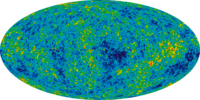
Photo from wikipedia
Higgs inflation and $R^2$-inflation (Starobinsky model) are two limits of the same quantum model, hereafter called Starobinsky-Higgs. We analyse the two-loop action of the Higgs-like scalar $\phi$ in the presence… Click to show full abstract
Higgs inflation and $R^2$-inflation (Starobinsky model) are two limits of the same quantum model, hereafter called Starobinsky-Higgs. We analyse the two-loop action of the Higgs-like scalar $\phi$ in the presence of: 1) non-minimal coupling ($\xi$) and 2) quadratic curvature terms. The latter are generated at the quantum level with $\phi$-dependent couplings ($\tilde\alpha$) even if their tree-level couplings ($\alpha$) are tuned to zero. Therefore, the potential always depends on both Higgs $\phi$ and scalaron $\rho$, hence multi-field inflation is a quantum consequence. The effects of the quantum (one- and two-loop) corrections on the potential $\hat W(\phi,\rho)$ are discussed, to conclude that the Starobinsky-Higgs model is in general stable in their presence. Two special cases are also considered: first, for a large $\xi$ in the quantum action one can integrate $\phi$ and generate a "refined" Starobinsky model which contains additional terms $\xi^2 R^2\ln^p (\xi \vert R\vert/\mu^2)$, $p=1,2$, ($\mu$ is the subtraction scale). This case generates corrections linear in the scalaron to the "usual" Starobinsky potential and a "running" scalaron mass. Second, for a small (fixed) higgs field $\phi^2 \ll M_p^2/\xi$ and a vanishing classical coefficient of the $R^2$-term, "usual" Starobinsky inflation is generated by quantum corrections for a suitable non-minimal coupling ($\xi$).
Journal Title: Physical Review D
Year Published: 2018
Link to full text (if available)
Share on Social Media: Sign Up to like & get
recommendations!